
Like people, dogs have a ton of activities that make them happy. Some of them might seem puzzling to you as an owner, but they make perfect sense when you know a little about your dog’s instincts, biology and social preferences.
1. Stashing Your Pretties
They often snatch them away, taking them to other rooms and hiding them in places like under cushions or in the laundry.
Some dogs like stealing bling because of the ingrained urge to preserve excesses. Before dogs were domesticated, meals weren’t guaranteed. Any leftovers got buried, which helped preserve the extra food. The dogs would come back and eat what they had buried later when they wanted or needed it.
For other dogs, the behavior is enjoyable because it keeps boredom at bay, giving them something to do.
It also can make lonely dogs feel better because they have a memento of yours that has your scent.
Another theory is that, like young children, dogs are willing to take whatever attention they can get, even if it’s negative. They hide your stuff because they like the interactions they get once you want the items back. In these cases, you might need to leave some puzzles for your pet or invest more time with them to get the behavior to stop.
2. Making Its Bed
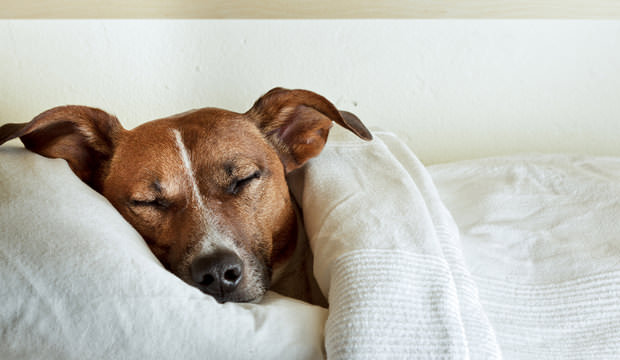
The most basic form of doing this is walking around in circles a few times. The habit goes back thousands of years to when dogs would make small nests for themselves by stomping down the grass.
By doing this, the dogs got their scent on the area, signaling to other animals that they’d claimed some territory for themselves. They also exposed the cooler ground below the grass somewhat, which helped them regulate their body temperatures.
Although some dogs are content to take a stroll around their doggy bed and simply call it a night, others are surprisingly fussy. They might insist on dragging over a particular towel or blanket, or they might go collect one (or all) of their favorite items to have them nearby.
Once they have their things in their sleeping area, they feel more secure and happy. Some dogs can become overanxious if they cannot find bedding items they’re emotionally attached to. Others end up tearing up their bedding intentionally or unintentionally with their nails and teeth.
3. Swimming

A dog who does a cannonball into the pool or lake isn’t necessarily trying to play lifeguard, though.
Many breeds truly love the water and are happy to use a good swim as a fun exercise alternative to their afternoon walk.
In fact, many vets recommend it as an activity for older dogs that often have issues with their joints.
Swimming is also good on hot summer days because it helps your dog stay cool.
Even though swimming is a terrific way to engage your dog in something physical, you do need to take some precautions. Dogs can swim in regular pools just like you, but make sure to give them a good rinse afterward. The chlorine can wreak just as much havoc on their fur as it can on your own hair.
Lakes and ponds sometimes can contain harmful bacteria or other contaminants, and in some regions, creatures like leeches might be lurking. Always check with your local parks and recreation departments or your facility host to see if it’s safe for you and your pooch to get in the water.
4. Doing Puzzles
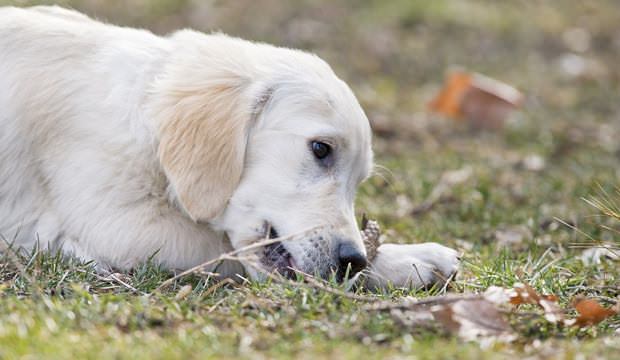
Most dogs are happier when you give them puzzles, which keep their minds active and help them pass the time.
Certain types of puzzles also can help your dog work out excess energy so he stays fit and sleeps better.
One of the most common puzzles dogs love is the food puzzle, which you should use to feed your dog at least one of its meals. Instead of just leaving the dog with a bowl full of food, you put the puzzle in a container that requires the dog to lick, chew, shake or paw to get something to eat.
Veterinarians point out that it’s actually pretty natural for your dog to work in this way, because in the wild, dogs would spend a lot of time scavenging. Simply hiding a few treats under cushions can be a good game for your dog, too.
Other toys, such as the Intellibone, aren’t food related, but they can satisfy the desire for chewing, getting your dog to work pieces apart. Many are soft and are designed to go right in the washer when they’re dirty.
5. Eating in Private
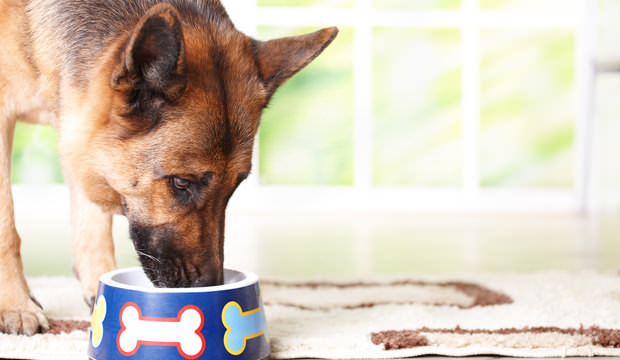
People tend to come together to eat, even if it’s just for a quick bite on a break at work.
The way they eat is based on the alpha hierarchy, however, with the pack leader usually playing dominance and getting first fruits.
To a domesticated dog, you are the alpha, so Fido might feel more comfortable eating in a private space where it knows you’re not going to lay claim to its grub. Be aware, too, that this kicks in when you give out treats.
Don’t be surprised if your dog takes what you give it to another room to savor, and check that it’s really eating them instead of just responding to instinct and hiding the extras.
Another reason dogs love to eat in their own space is that they can be free of distractions. If their food is in an area of your house where there’s a ton of foot traffic or visual stimulation, it can make them nervous to the point where they don’t eat as they should. That can put them at risk for nutritional problems that put their health at risk.
6. Frozen Eats
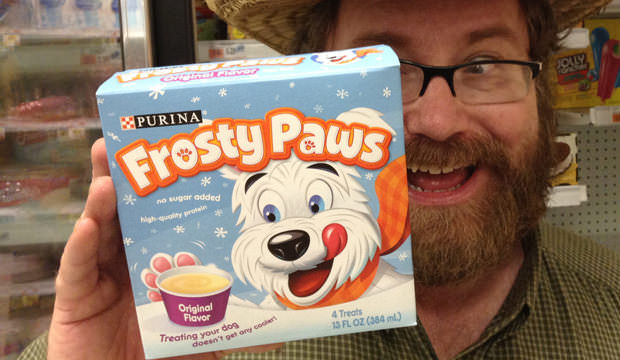
When they pant, they let hot, moist air out of their mouth and take in air that’s cooler.
That cooler air lowers the temperature of the blood vessels in the dog’s head, and the cooler blood circulates through the dog’s entire body.
When your dog can eat or lick something cold, this process gets an added boost, helping your pooch cool down fast when they’re overheated.
Many prepackaged wet dog foods freeze into “pupsicles” fairly easily, but you might want to use your own recipe for your dog’s treats, especially if your dog has special nutritional needs. Keep in mind, too, that many items people freeze, such as grapes, are potentially toxic to dogs.
Always check with your vet or a group like ASPCA to make sure your ingredients are okay. One recipe you might want to try that’s approved by the Humane Society of the United States is for peanut butter popsicles, which are simply made with just peanut butter, mashed banana and a little water.
7. Listening to Music

In fact, when dogs howl, they pay special attention to what other dogs sound like, purposely changing their tone so they are heard as unique.
These animals might not “sing” the way people do, but their sense of pitch does affect how they hear music, and it influences their mood in the same way experts believe it influences the emotions of people.
Research by psychologist Deborah Wells at Queens University in Belfast found that classical music calmed dogs, whereas heavy metal made them agitated. Some experts believe that dogs particularly like vocal music. The sound of the human voice may quell loneliness for some animals. Another theory is that, when dogs hear sustained vocal tones, they instinctively respond, howling because they want to respond and communicate.
Every dog is different with music, so watch your pet and just take your cues about what to play from how they respond. Also, remember that dogs have a great sense of hearing and don’t need high volumes. Don’t crank up the stereo even to play his favorite song, as it could hurt his ears.
8. Getting Stinky
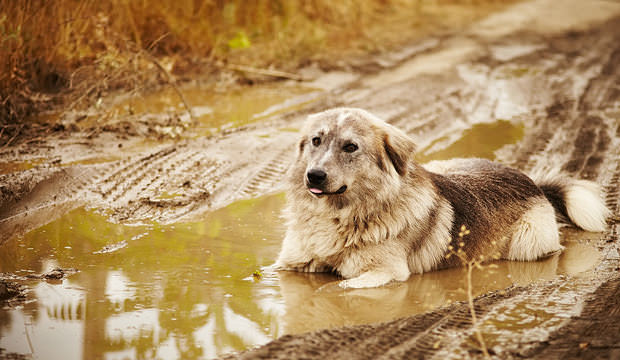
Dogs love to roll around in anything that stinks, even garbage, because the scents in those materials help mask the dogs’ own odors.
It’s a natural version of an invisibility cloak, disguising the fact the dog is nearby. In the wild, dogs rely on this in order to sneak up on and catch their prey, as well as to avoid getting found and eaten themselves.
In some cases, dogs also roll around in items with a strong scent because they love the smell so much they want to take it with them, just as people wear perfume.
Just because your dog loves getting smelly doesn’t mean you’re going to love its odor. Some trainers recommend that, if the behavior is problematic, you make what normally would be pleasurable (the rolling in stinky stuff) less enjoyable, such as by giving the dog a quick squirt with a bit of water when you see it doing it. They also recommend keeping your dog on a short leash and being insistent that the dog come when it is called.
9. Sitting on Your Feet

According to experts, though, sitting on your feet isn’t just a sign of adoration. It’s primarily a way to send a message to other animals that you belong to your dog and are spoken for.
It does this not only by the physical proximity, but also by transferring his scent to you. With the dog seeing you as his, foot sitting can also be a way to protect you, as anybody else who wants to get to you has to deal with the dog first.
For some dogs, foot sitting isn’t so much about marking or protecting you as it is the dog lacking confidence. By getting right on top of you, the dog is trying to assert a little control, hoping you won’t leave it.
Your warmth and scent are also a bit of a security blanket, and your dog might learn that you’ll pay attention and offer petting or other rewards when he’s super close. Simply spending more time with the animal sometimes helps when this is the case.
10. Licking
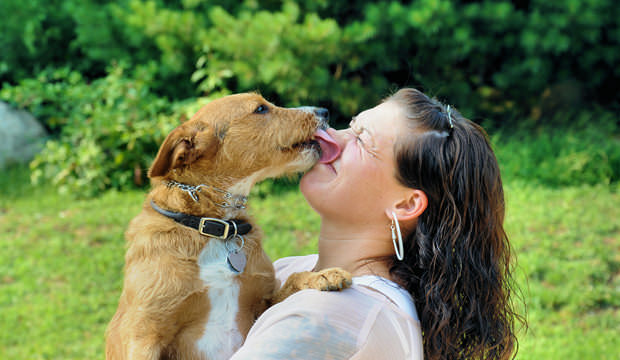
In a lot of cases, though, licking happens for more instinctive reasons. It is a way for them to show that they are submissive to another dominant animal (you).
Dogs also enjoy licking as a self-soothing behavior, much like little kids will suck their thumbs when they’re upset.
Although most dogs use it to groom to some extent, certain breeds are more obsessive about it than others. A good lick also can be your dog’s way of trying to get your attention and spend time with it.
For puppies, licking has a special purpose. They like to do it when they are hungry, because for them, it is a way to ask their mother for food. If your dog is grown, he might be compulsively licking simply because he honestly likes the way you taste, as many dogs love how salty the skin is. If this is the case for your animal, you might notice that the licking peaks when you’ve hit the gym or during other times where you’re sweating more.
11. Going To New Places
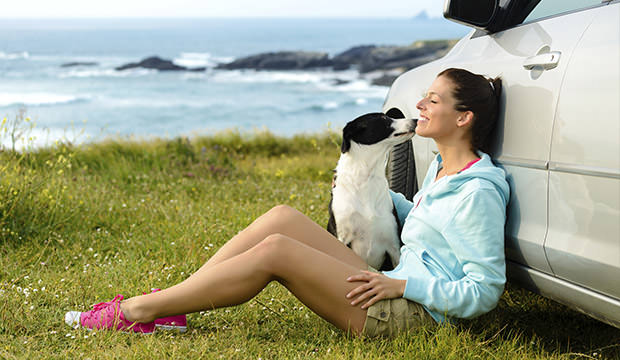
For starters, new environments present both mental and physical stimulation for your pooch.
Each new path gives your dog new things to see and smell and figure out, and just as hiking is different than walking on a treadmill, different routes push your dog’s body to develop better strength, endurance and balance.
As with many other dog behaviors, trying out new routes also connects to your pet’s natural instinct to move around. In the wild, dogs have nothing given to them, including food and shelter. Subsequently, they constantly are migrating to new locations in order to find what they need to survive. In fact, it’s not at all unusual for them to travel several miles a day between hunting, playing and exploring.
Even though going to new places can fit your dog’s instincts and keep it stimulated, be aware that new places can have hidden dangers, such as toxic plants, wild animals or other aggressive dogs. Scout out the places you’d like to visit before you take your dog along to keep it safe.
12. Carrying Things Around
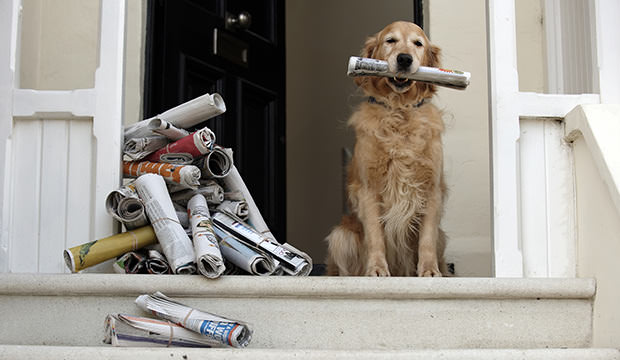
They think that, if they leave the items alone, another more dominant dog may come and find them and take them away. They carry their things around to make sure they can maintain their ownership.
Exactly why dogs want to keep possession of something is a little more complex, however.
It sometimes has to do with the fact that a particular item is comforting, which usually relates to familiarity or an enjoyable texture, taste or scent. It’s a lot like the “Peanuts” character Linus dragging around his security blanket. Some items get dragged around because they’re the most entertaining thing the dogs have at the moment.
Then there’s the fact that dogs act on their hierarchy instincts. If your dog carries items around only to drop them at your feet, it can mean that your pet is recognizing your position as the alpha.
It presents you with “gifts” not so much to please you, but rather to show you that it knows you get first dibs. There might be items that dogs are honestly proud to have, too, in which case they carry them around much like trophies to show them off.
13. Following Your Rules
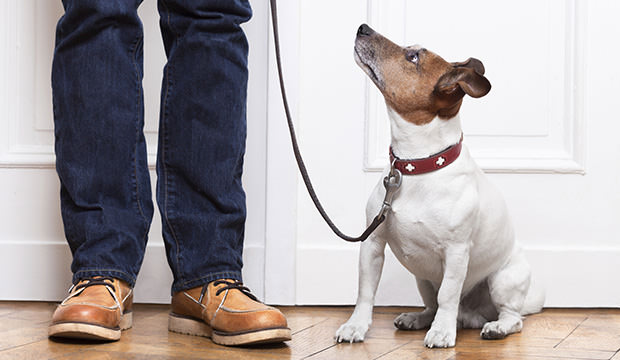
Alphas take a brilliant I-won’t-yell-for-your-attention strategy, commanding submissiveness with cool, calm leadership.
In the end, this is reassuring to the rest of the pack, which has very clear direction and sees the alpha as strong and confident.
In your home, you are the alpha, and your dog will look to you to see what is acceptable. Fail to do this and your dog might get upset or anxious, unsure of the role it needs to take.
It is your responsibility to respond not with harshness, but with firm, consistently enforced discipline. This treatment keeps your dog’s behavior in line not because the animal is afraid of you, but because you don’t give it any tension, anxiety or anger to feed off of – most poor behaviors dogs exhibit are simply a response to stress and confusion.
In this sense, good obedience training and the establishment of order is as much about keeping your dog happy as it is protecting the animal, you, other people and your stuff. Essential rules to teach are to sit/lie down/stay, leave/drop objects, come, and, of course, to go to the toilet where they’ve been trained to do it. Structure wins every time.
14. Sitting In A Dog Crate
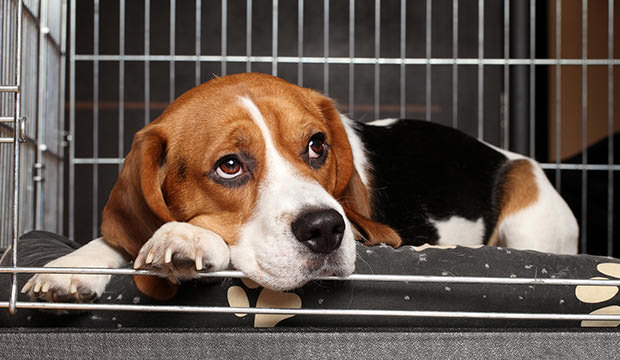
Even though dogs are naturally somewhat migratory, their dens still serve as a home, a place where they can feel safe and get away from things that are overwhelming or bothering them.
In the modern home, your dog’s den is the dog crate.
There are a few major keys to creating a great crate for your dog. The first is to avoid using the crate for punishment at all costs. Remember, the crate is meant to be your dog’s happy place!
Secondly, your dog should be able to move around comfortably with plenty of space, and it should be able to come and go from the crate as it pleases, just as it would leave and come back to its den in the wild.
Third, put items in the crate that make the space comfortable for your animal, such as its dog bed, a favorite toy or a dog puzzle. Lastly, pick a spot for the crate that is somewhat private, just as you do for the placement of its water and food.
If the crate is where everyone has to walk or there’s a lot of noise or other stimulation, your pet won’t be able to relax very well.
15. Making Friends
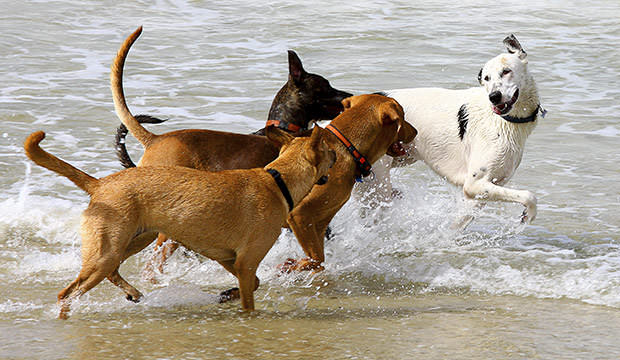
They don’t particularly need to be around other dogs–this is a misconception centered around the fact dogs usually form packs with their family members–but they do need meaningful friendships, be it with another dog, the neighbor’s exotic pet monkey or the goose on your family farm.
As your dog’s alpha, you never quite can meet this need, because the relationship you form with your pet is more like that of a parent and child, not that of buddies.
Most dogs adjust to being around other dogs pretty easily, but keep in mind that they’ll still try to figure out where they fit in the normal pack hierarchy. It’s always advisable to let your dog meet others in a very structured way, such as starting with parallel walking so the animals can check each other out first from a distance.
If your dog continues to show signs of stress, such as repeated growling that doesn’t abate, call it a day and try again at another time. Keep in mind that animals can be less receptive if they don’t feel well or are older, too.
16. Watching TV
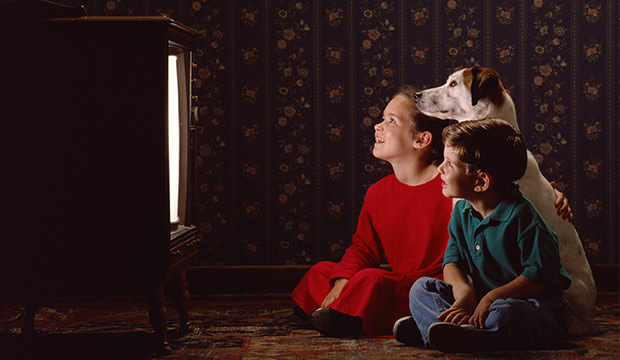
Still, today’s high-quality televisions can provide good entertainment to your pooch.
In fact, there’s now an entire cable channel, DogTV, dedicated to providing scenes like bouncing balls, relaxing landscapes and even things like vacuums for help with desensitization.
The constant action and attraction-getting sounds of these types of short scenes help your dog pass a little time without a lot of fuss.
Experts recognize that dogs can fight boredom in front of the screen, but they caution that television isn’t a substitute for good one-on-one care. Even if your dog gets a little mental stimulation from what it sees, it still needs physical exercise in order to stay happy and healthy.
Think giving your dog something to focus on for a few minutes while you get dinner or hop in the shower, not leaving it in front of the tube for hours at a time while you’re at work. Remember, too, that instincts can kick in. Don’t get upset at your dog if it lunges for a squirrel in a show, for example.
17. Taking Classes
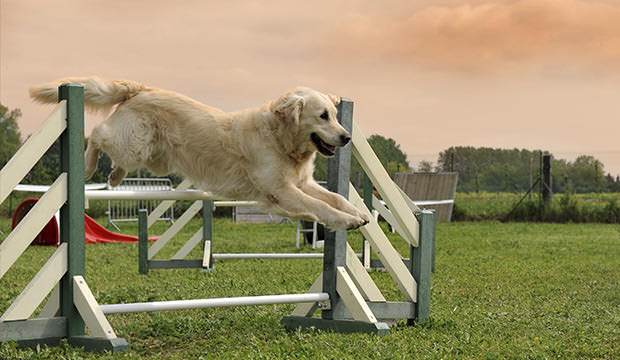
One of the best options is some classes in basic obedience training, which can reinforce or teach new rules that help your dog get his behavior under control.
Even so, there are a lot of other functional options, such as getting your dog trained to work as a therapy dog. These classes challenge it mentally and keep it alert.
Mental growth and development aren’t the only reasons to enroll your dog in a class, though. You can find classes that give your animal plenty of physical exercise, too, such as a Frisbee, agility or lure coursing.
Regardless of whether you’re looking for a mental boost, physical support or both, one thing to keep in mind when you pick a class for your dog is that other dogs in the class can be a distraction.
Your dog might need a little one-on-one focusing work before it can work well in a group setting, and you’ll want to take the time for your dog to get to know the others. The fact some breeds do better with particular activities because of their temperament also matters, as does current health and age.
18. Coming With You To Run Errands
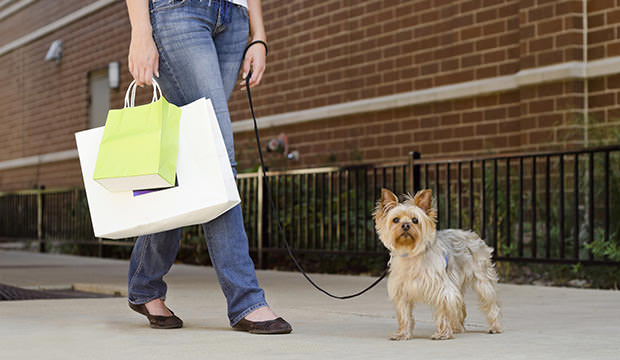
You might need to run to the ATM, for example, or you might have to pick up your dry cleaning.
As long as the weather is such that the temperature in your vehicle is easy to control and won’t cause your dog anxiety, these types of errands are all great opportunities for some mental stimulation for your dog.
It will enjoy your company as much as it gets a kick out of what it sees and hears and smells. Going out in this way also plays to your dog’s natural desire to explore and roam, all while keeping it well within safe boundaries.
Another benefit of getting out of the house with your dog is that it gives you the opportunity to work with it in different environments. For instance, you can teach it to sit automatically at curbs for safety. You also can get your dog acclimated to traveling in the car and being around other people.
Many owners find that dogs prone to separation anxiety get some relief, too–remember, in the wild, the submissives naturally follow their pack leader, feeling more comfortable when they know it is still around.
19. Taking A Nap
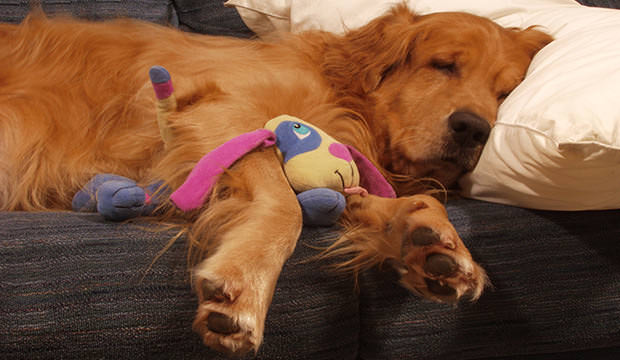
Not surprisingly, humans suffer the consequences, falling prey to problems like weakened immune systems and poor mental concentration.
Dogs, by contrast, don’t see stretching out in their dog beds as a sign of laziness. They respond to their bodies’ cues well and will rest when they’ve reached their physical limits.
Dogs are more than happy to take a snooze while cuddling their owners or others in the household, but many experts say that it’s best to get your dog to sleep in their own space, such as their crate or their dog bed.
Part of this is for safety, as you won’t accidentally roll on your pooch and it won’t get jolted awake and nip instinctively in surprise. Having it nap in its own area also means you don’t get pet hair and dander in parts of your house that are more work to clean.
Dogs can also keep you from good rest with their shifting. Plus, you want to keep very clear lines about who is alpha and who isn’t. Letting your dog share your space sometimes can be confusing for it.
20. Doing Jobs
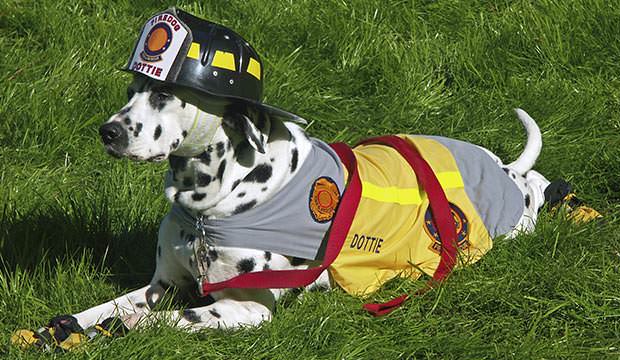
Not only that, but many breeds of modern, domesticated dogs are bred specifically to work, such as herding or hunting dogs.
If you don’t acknowledge your dog’s natural inclination to do jobs, it will get bored and restless, which can lead to an increase in behavioral issues. Having nothing to do and not being acknowledged also can make your dog depressed and lonely.
Jobs you pick for your dog can be fairly simple, such as retrieving your slippers or carrying your water bottle in a specially-fitted backpack. Work can also be what you might think of as games, such as bringing back a ball to you after you throw it.
After your dog performs the job well, it’s perfectly fine to reward it for his efforts, be it with some petting, a tasty treat or the chance to romp with another dog. Just make sure that whatever rewards you provide are given immediately after the behavior you like.
Immediate rewards help your dog mentally connect that what they’ve just done is something positive and worth repeating, establishing trust between you and your animal.

Yes, yogurt is perfectly safe for dogs, in fact it is given to dogs to stop or prevent seizures. Just give in moderation……or they can get very soft or even runny stool.
I never did the fancy frozen treats for my dogs, but i’ve never had a dog who didn’t love chomping on a couple ice cubes.
just like when people jump into ice cold water the muscles freeze up and that can happen if they somethings to cold
All these are pretty obvious especially sitting in a dog crate, she’s actually next to me in her crate
My girl likes to sit on my feet. Sometimes I have to kick her off because my feet are falling asleep (she’s almost 70 lbs)
One should never give dogs yogurt with sugar in it due to sugar being inflammatory and feeding yeast. Grains, oats, potatoes, peas, sweet potatoes, rice all feed yeast. After over $3000 in vet bills for a nasty yeast infection on my dogs skin, I finally figured it out and therefore, I no longer feed my dog anything from PETsMART or Petco.
and dogs also like carob